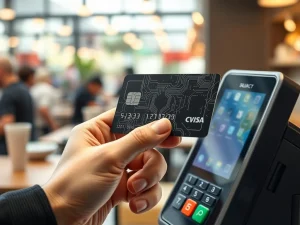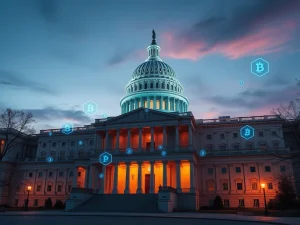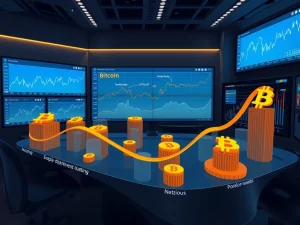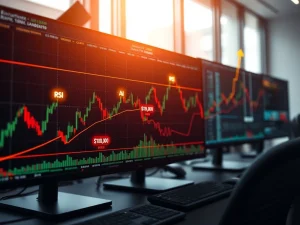XRP Propels Financial Revolution: Analyst Forecasts SWIFT’s Obsolescence in Global Payments
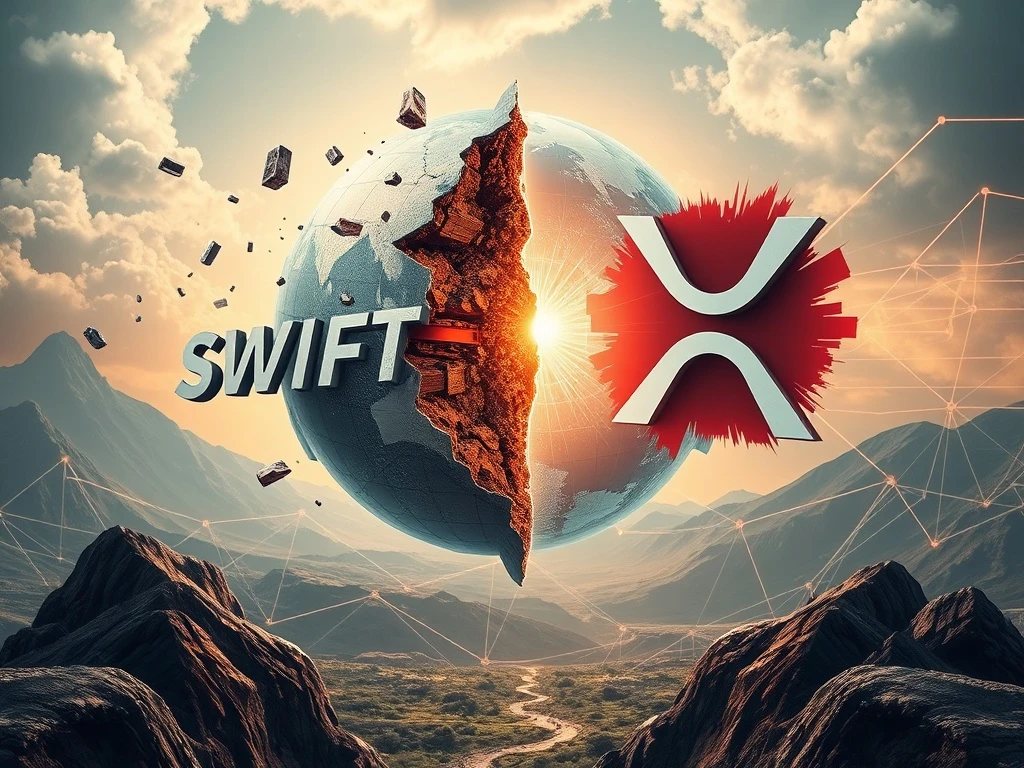
The world of global finance is on the brink of a monumental transformation. For decades, the SWIFT network has been the undisputed backbone of international money transfers. Yet, a powerful new contender, XRP, is rapidly gaining ground, promising a true financial revolution. Could SWIFT, the long-standing titan, finally be facing obsolescence?
SWIFT’s Lingering Legacy: Why Change is Inevitable for Global Payments?
The Society for Worldwide Interbank Financial Telecommunication (SWIFT) has been instrumental in facilitating secure messaging between financial institutions for over 50 years. Connecting more than 11,000 banks and organizations across 200+ countries, it’s a critical piece of the global financial infrastructure. However, its foundational design, rooted in a bygone era, presents significant challenges in today’s fast-paced digital economy. Crypto analyst Pumpius suggests that these inefficiencies are pushing SWIFT towards obsolescence.
Key Criticisms of SWIFT:
- Sluggish Processing Times: International transfers can take days to settle, leading to delays and liquidity lock-ups.
- High Costs: Multiple intermediary banks often add their fees, making cross-border transactions expensive and opaque.
- Lack of Transparency: Real-time tracking of funds is often limited, causing uncertainty.
- Geopolitical Vulnerability: Its centralized nature also makes it susceptible to political weaponization, as seen with sanctions, creating demand for neutral alternatives.
XRP’s Ascendance: A New Paradigm for Cross-Border Transactions
In stark contrast to SWIFT’s traditional framework, XRP, the digital asset native to the XRP Ledger (XRPL), offers a compelling alternative for cross-border transactions. Pumpius argues that XRP is emerging as a strategic replacement due to its inherent advantages, positioning it as a ‘new chesspiece’ in global finance.
How XRP Transforms Payments:
- Blazing Speed: Transactions on the XRPL settle in mere seconds, offering near real-time finality.
- Minimal Cost: Fees are typically fractions of a cent, drastically reducing the expense of international transfers.
- Direct Value Transfer: Unlike SWIFT’s messaging system, XRP enables direct value transfer, bypassing multiple intermediaries.
- Enhanced Liquidity: XRP acts as a bridge currency, facilitating immediate liquidity between disparate fiat currencies.
This efficiency aligns with the demands of a modern economy that prioritizes transparency and speed, directly challenging SWIFT’s decades-old protocols.
The Ripple Effect: Institutional Validation and Global Payments Adoption
Ripple, the company behind XRP, has made significant strides in driving institutional adoption through its On-Demand Liquidity (ODL) system. ODL leverages XRP to bridge fiat currencies across borders, providing instant settlement and reducing pre-funded nostro/vostro accounts. Over 100 financial institutions worldwide have adopted this system, underscoring the practicality of blockchain-based solutions for global payments.
Beyond ODL, countries exploring Central Bank Digital Currencies (CBDCs) are reportedly considering XRPL technology to enhance cross-border interoperability. This signals a broader shift in financial infrastructure priorities, where distributed ledger technology (DLT) is seen as a key enabler for future financial systems.
Is a Financial Revolution Underway? The Ideological Shift in Global Finance
The potential decline of SWIFT is not solely a technological shift; it’s an ideological one, as Pumpius highlights. The weaponization of SWIFT, exemplified by the exclusion of certain nations from its network, has created a strong demand for a politically neutral alternative. XRP‘s decentralized nature and global reach align perfectly with this need, particularly in an era marked by rising geopolitical tensions between East and West. This fundamental shift reflects a transfer of power from legacy institutions to more decentralized networks, paving the way for a true financial revolution.
XRPL’s Explosive Growth: Capturing a Share of Global Payments
Data from CryptoQuant provides compelling evidence of XRPL’s surging adoption, with active wallets exceeding 7.24 million – a record high. This growth is a confluence of factors including retail enthusiasm, increasing institutional backing, and ongoing network upgrades. Analysts suggest that continued cross-border adoption, the rise of real-world asset tokenization on the XRPL, and new institutional partnerships could drive XRPL’s ecosystem to capture up to 14% of global payments volume in the coming years. This forecast underscores XRP’s potential to significantly disrupt the existing payments landscape.
Navigating the Future: Challenges and Opportunities for XRP
While the outlook for XRP appears promising, the transition from SWIFT to blockchain-based solutions hinges on critical factors. Broader regulatory clarity across jurisdictions is paramount for mainstream institutional adoption. Furthermore, continued technological advancements, scalability improvements, and robust security measures remain essential for XRP’s long-term viability and its role in reshaping global payments.
Comparison: SWIFT vs. XRP for Cross-Border Payments
| Feature | SWIFT | XRP (via ODL) |
|---|---|---|
| Settlement Time | Days | Seconds |
| Transaction Cost | High (multiple fees) | Very Low (fractions of a cent) |
| Transparency | Limited tracking | Real-time, immutable ledger |
| Intermediaries | Multiple correspondent banks | Few to none |
| Liquidity | Requires pre-funded accounts | On-demand via XRP |
| Control | Centralized | Decentralized network |
Conclusion: XRP’s Defining Moment in Global Finance
The narrative is clear: the traditional financial system is facing an unprecedented challenge from decentralized blockchain solutions. XRP, with its speed, cost-efficiency, and growing institutional adoption, is at the forefront of this shift. Pumpius’s analysis highlights not just a technological upgrade but an ideological pivot towards a more open, efficient, and geopolitically neutral financial world. While challenges remain, particularly in regulatory clarity, the momentum behind XRP and the XRPL ecosystem suggests it is poised to play a pivotal role in the future of cross-border transactions and the broader financial revolution.
Frequently Asked Questions (FAQs)
1. What is SWIFT and why is it considered inefficient for modern global payments?
SWIFT (Society for Worldwide Interbank Financial Telecommunication) is a messaging network used by financial institutions worldwide to send and receive information about financial transactions. It’s considered inefficient for modern payments due to its slow processing times (days for settlement), high costs from multiple intermediaries, and limited real-time transparency. Its centralized nature also makes it susceptible to geopolitical weaponization.
2. How does XRP aim to replace or improve upon SWIFT for cross-border transactions?
XRP aims to improve upon SWIFT by offering significantly faster (seconds vs. days) and cheaper (fractions of a cent) cross-border transactions. It enables direct value transfer without multiple intermediaries, providing real-time settlement and enhanced liquidity through Ripple’s On-Demand Liquidity (ODL) system. This makes international payments more efficient and transparent.
3. What is Ripple’s On-Demand Liquidity (ODL) system?
On-Demand Liquidity (ODL) is a service offered by Ripple that leverages XRP to facilitate instant and low-cost cross-border payments. Instead of pre-funding accounts in destination currencies, financial institutions use XRP as a bridge currency to convert from one fiat currency to another in real-time, significantly reducing operational costs and freeing up capital.
4. What role could XRP play in Central Bank Digital Currencies (CBDCs)?
The XRP Ledger (XRPL) technology is being explored by countries for its potential to enhance cross-border interoperability for Central Bank Digital Currencies (CBDCs). XRPL’s speed, scalability, and ability to handle high transaction volumes make it a viable platform for facilitating seamless transfers and exchanges between different CBDCs globally.
5. What challenges does XRP face in achieving widespread adoption in global payments?
Despite its advantages, XRP faces challenges including the need for broader regulatory clarity across different jurisdictions. The ongoing legal landscape and varying global regulations can impact its widespread institutional adoption. Additionally, continued technological advancements and maintaining network security are crucial for its long-term viability.

